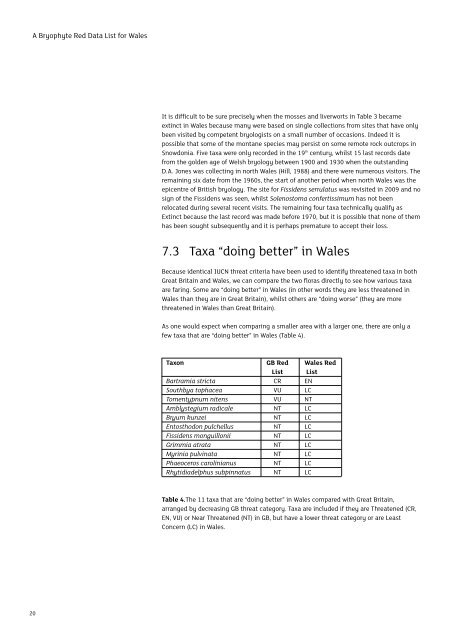Download this publication - Plantlife
Download this publication - Plantlife
Download this publication - Plantlife
Create successful ePaper yourself
Turn your PDF publications into a flip-book with our unique Google optimized e-Paper software.
A Bryophyte Red Data List for Wales<br />
20<br />
It is difficult to be sure precisely when the mosses and liverworts in Table 3 became<br />
extinct in Wales because many were based on single collections from sites that have only<br />
been visited by competent bryologists on a small number of occasions. Indeed it is<br />
possible that some of the montane species may persist on some remote rock outcrops in<br />
Snowdonia. Five taxa were only recorded in the 19 th century, whilst 15 last records date<br />
from the golden age of Welsh bryology between 1900 and 1930 when the outstanding<br />
D.A. Jones was collecting in north Wales (Hill, 1988) and there were numerous visitors. The<br />
remaining six date from the 1960s, the start of another period when north Wales was the<br />
epicentre of British bryology. The site for Fissidens serrulatus was revisited in 2009 and no<br />
sign of the Fissidens was seen, whilst Solenostoma confertissimum has not been<br />
relocated during several recent visits. The remaining four taxa technically qualify as<br />
Extinct because the last record was made before 1970, but it is possible that none of them<br />
has been sought subsequently and it is perhaps premature to accept their loss.<br />
7.3 Taxa “doing better” in Wales<br />
Because identical IUCN threat criteria have been used to identify threatened taxa in both<br />
Great Britain and Wales, we can compare the two floras directly to see how various taxa<br />
are faring. Some are “doing better” in Wales (in other words they are less threatened in<br />
Wales than they are in Great Britain), whilst others are “doing worse” (they are more<br />
threatened in Wales than Great Britain).<br />
As one would expect when comparing a smaller area with a larger one, there are only a<br />
few taxa that are “doing better” in Wales (Table 4).<br />
Taxon GB Red Wales Red<br />
List List<br />
Bartramia stricta CR EN<br />
Southbya tophacea VU LC<br />
Tomentypnum nitens VU NT<br />
Amblystegium radicale NT LC<br />
Bryum kunzei NT LC<br />
Entosthodon pulchellus NT LC<br />
Fissidens monguillonii NT LC<br />
Grimmia atrata NT LC<br />
Myrinia pulvinata NT LC<br />
Phaeoceros carolinianus NT LC<br />
Rhytidiadelphus subpinnatus NT LC<br />
Table 4.The 11 taxa that are “doing better” in Wales compared with Great Britain,<br />
arranged by decreasing GB threat category. Taxa are included if they are Threatened (CR,<br />
EN, VU) or Near Threatened (NT) in GB, but have a lower threat category or are Least<br />
Concern (LC) in Wales.

















